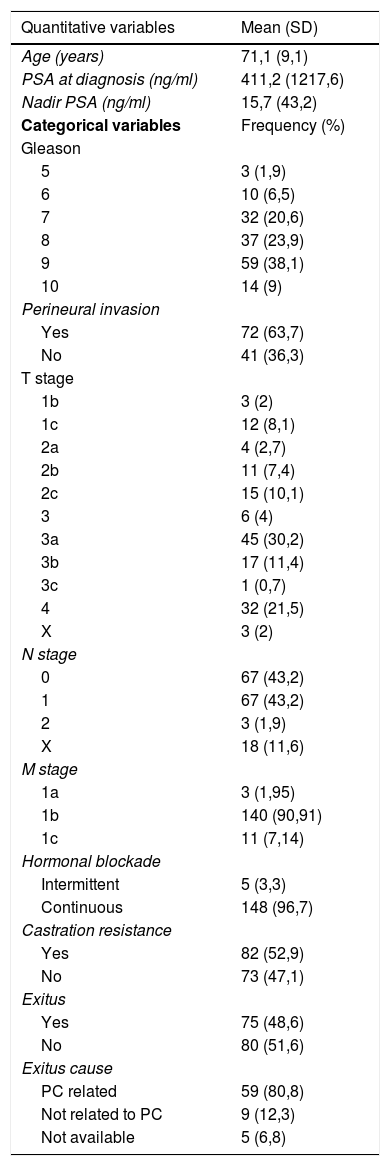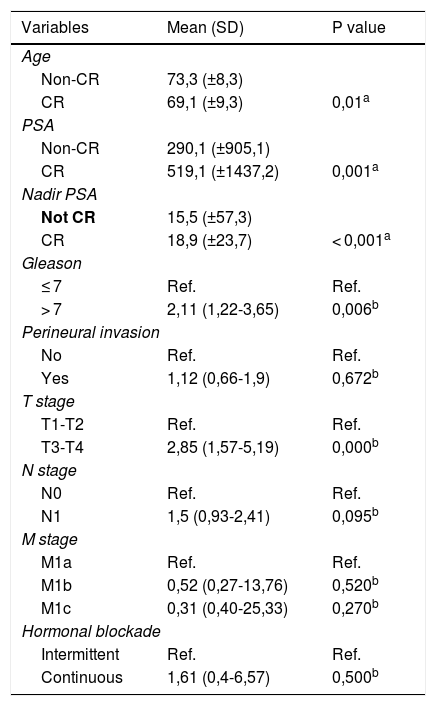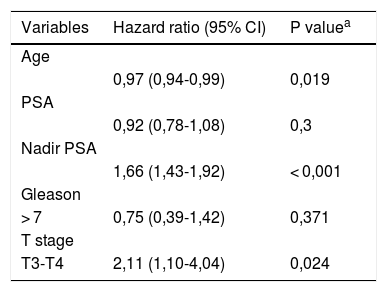The objective of the study was to determine the factors independently related with the development of castration resistance (CR) in prostate cancer (PC) in the medium term.
Material and methods155 patients diagnosed with metastatic PC with a follow-up of up to 39 months. Data taken from the National PC Registry.
The evaluated variables were age, PSA, nadir PSA, Gleason, perineural invasion, TNM stages, and ADT type (intermittent / continuous).
ResultsMean follow-up 26,2 ± 13,4 months. 47.1% developed early CR, with mean time until onset of 12,2 ± 8,7 months.
Univariate analysis: the mean PSA was correlated with CR (290 ± 905,1 ng/mL in non CR, 519,1 ± 1437,2 ng/mL in CR, p < 0,001), mean age (73,3 ± 8,3 years in non CR, 69,1 ± 9,3 in CR p = 0.01), mean PSA nadir (15,5 ± 57,3 ng/mL in non CR, 15,9 ± 23,7 ng/mL in CR, p < 0,001), Gleason (in ≥8, HR:2,11. 95% CI: 1.22-3.65, p = 0.006), and T stage (in T3-T4, HR: 2.85. 95% CI: 1.57-5.19, p < 0,001).
Multivariate analysis: the independent variables associated to CR are age (HR: 0.96. 95% CI: 0.94-0.99, p = 0.01), PSA nadir (HR: 1.65. 95% CI: 1,43–1,91, p < 0,001), and T3-T4 stage (HR: 2.11. 95% CI: 1.10–4.04, p = 0.02).
ConclusionsPSA nadir and T3-T4 tumor stage at diagnosis are associated to an increased risk of developing CR. In addition, age at diagnosis is shown as a variable that decreases risk. Therefore, an older age would be associated with lower risk probability of CR in the medium term.
Objetivo del estudio fue establecer los factores que se relacionan de forma independiente con el desarrollo de resistencia a la castración (RC) a medio plazo en el cáncer de próstata (CP).
Material y métodos155 pacientes con CP metastásicos al diagnóstico del registro nacional de CP con un seguimiento de hasta 39 meses.
Las variables estudiadas fueron: edad, PSA, nadir de PSA, Gleason, invasión perineural, estadios T, N y M, y tipo de bloqueo (intermitente/continuo).
ResultadosMedia de seguimiento 26,2 ± 13,4 meses. 47,1% desarrolló RC precoz, con una media hasta el desarrollo de RC 12,2 ± 8,7 meses.
Análisis univariante, se relacionaron con la RC la media de PSA (290 ± 905,1 ng/mL en no RC, 519,1 ± 1437,2 ng/mL en RC, <0,001), media de edad (73,3 ± 8,3 años en no RC, 69,1 ± 9,3 en RC, p = 0,01), media de nadir de PSA (15,5 ± 57,3 ng/mL en no RC, 15,9 ± 23,7 ng/mL en RC, <0,001), Gleason (en ≥8, HR:2,11. IC 95%: 1,22–3,65, p = 0,006), y estadio T (en T3-T4, HR: 2,85. IC 95%: 1,57–5,19, <0,001).
Análisis multivariante, las variables independientes relacionadas con la RC son, edad (HR:0,96. IC95%:0,94–0,99, p = 0,01), nadir de PSA (HR:1,65. IC95%:1,43–1,91, p < 0,001), y estadio T3-T4 (HR:2,11. IC95%:1,10-4,04, p = 0,02).
ConclusionesEl nadir de PSA y un estadio tumoral T3-T4 al diagnóstico se relacionan con un riesgo aumentado de desarrollar RC. Además, la edad al diagnóstico se muestra como una variable que disminuye el riesgo, de forma que, a más edad, menos riesgo de desarrollar RC a medio plazo.










